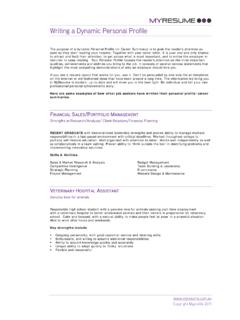Transcription of PHARMACEUTICAL PRICING AND …
1 DELSA/HEA/WD/HWP(2007)5. PHARMACEUTICAL PRICING AND. REIMBURSEMENT POLICIES IN SWEDEN. Pierre Mo se and Elizabeth Docteur 28. OECD HEALTH WORKING PAPERS. Unclassified DELSA/HEA/WD/HWP(2007)5. Organisation de Coop ration et de D veloppement Economiques Organisation for Economic Co-operation and Development 13-Sep-2007. _____. English - Or. English DIRECTORATE FOR EMPLOYMENT, LABOUR AND SOCIAL AFFAIRS. HEALTH COMMITTEE. Unclassified DELSA/HEA/WD/HWP(2007)5. Cancels & replaces the same document of 26 July 2007. Health Working Papers OCED HEALTH WORKING PAPERS NO.
2 28. PHARMACEUTICAL PRICING AND REIMBURSEMENT POLICIES IN SWEDEN. Pierre Mo se and Elizabeth Docteur JEL Classification: I18, I11. This document replaces the initial version of the report that, due to a production error, was missing the Introduction. This has now been corrected. English - Or. English JT03231887. Document complet disponible sur OLIS dans son format d'origine Complete document available on OLIS in its original format DELSA/HEA/WD/HWP(2007)5. DIRECTORATE FOR EMPLOYMENT, LABOUR AND SOCIAL AFFAIRS. OECD HEALTH WORKING PAPERS.
3 This series is designed to make available to a wider readership health studies prepared for use within the OECD. Authorship is usually collective, but principal writers are named. The papers are generally available only in their original language English or French with a summary in the other. Comment on the series is welcome, and should be sent to the Directorate for Employment, Labour and Social Affairs, 2, rue Andr -Pascal, 75775 PARIS CEDEX 16, France. The opinions expressed and arguments employed here are the responsibility of the author(s) and do not necessarily reflect those of the OECD.
4 Applications for permission to reproduce or translate all or part of this material should be made to: Head of Publications Service OECD. 2, rue Andr -Pascal 75775 Paris, CEDEX 16. France Copyright OECD 2007. 2. DELSA/HEA/WD/HWP(2007)5. ACKNOWLEDGEMENTS. The authors wish to thank the Ministry of Health and Social Affairs and the PHARMACEUTICAL Benefits Board (LFN) for helping to arrange the mission during which much of the information used in this report was collected. Special thanks go to Joakim Ramsberg for commenting on a draft version of this report.
5 Thanks are due also to the experts and stakeholders interviewed in the course of preparing this report, many of whom furnished data or publications referenced in the work: Anders Anell (The Institute for Health Economics ), Stefan Back (The Swedish Association of Local Authorities and Regions), Richard Bergstr m (Swedish Association of the PHARMACEUTICAL Industry), Helena Dahlgren (SBU), Anders Dahlqvist (The Swedish Medical Association), Ulrica Dyrke (Ministry of Industry, Employment and Communications), Kristina Ekelund (National Board of Health and Welfare), sa Elffors (Ministry of Health and Social affairs), Andreas Engstr m ( PHARMACEUTICAL Benefits Board)
6 , Elis Envall (National Board of Health and Welfare), Samuel H gg (Ministry of Justice), sa Kumlin (Medical Products Agency), Per Matses (Apoteket ), Sofia Medin (Ministry of Industry, Employment and Communications), Anne Nilsson (Ministry of Health and Social affairs), Kenneth Nyblom (Swedish Generic Manufacturers Association), Lars R nnb ck (Apoteket ), Sara Rosenm ller (Ministry of Health and Social affairs), Per- Arne Sundbom (The Competition Authority), Ann-Christin Taubermann ( PHARMACEUTICAL Benefits Board), Magnus Thyberg (The Swedish Association of Local Authorities and Regions), Cecilia Ulleryd (Medical Products Agency), Bengt Wennerstein (Ministry of Industry, Employment and Communications), Barbro Westerholm (The Swedish Association for Senior Citizens), and Monica Widegren (The Competition Authority).
7 The authors thank Lihan Wei for assistance in the production of tables and figures included in this report; Val rie Paris, Peter Scherer and Martine Durand, for their comments and suggestions; and Gabrielle Luthy and Marie-Christine Charlemagne for secretarial support. 3. DELSA/HEA/WD/HWP(2007)5. ABSTRACT. This paper examines aspects of the policy environment and market characteristics of the Swedish PHARMACEUTICAL sector, assesses the degree to which Sweden has achieved certain policy goals, and puts forth some key findings and conclusions.
8 Thanks to low mark-ups in the distribution chain and no VAT for prescribed medicines, Sweden's public prices for pharmaceuticals are relatively low, in contrast to average prices received by manufacturers, which are among the highest in Europe. Recent reforms have helped to restrain PHARMACEUTICAL expenditure growth, following a period of double digit growth in the 1990s. PHARMACEUTICAL expenditure per capita in Sweden is lower than the OECD average. Only five OECD countries devote less of their national income to pharmaceuticals.
9 What limited evidence exists tends to suggest that relatively low PHARMACEUTICAL expenditures in Sweden are due to its low public prices, rather than to low levels of consumption. Sweden introduced a new PRICING and reimbursement scheme in 2002. Its main features are the use of cost-effectiveness analysis for determining the reimbursement status of new pharmaceuticals and mandatory substitution of the lowest-cost generic alternative. The use of cost-effectiveness analysis in reimbursement decisions helps to relate the reimbursement price paid to the social value of the product, but does not necessarily result in the lowest possible price.
10 The generic substitution policy has enabled Sweden to achieve fairly high penetration of generic drugs into the market in terms of volume, with a considerably low share of the total value of the market. However, the requirement to substitute only the lowest-priced listed drug risks undermining the competitiveness of the generic drug industry. The Swedish pharmacy monopoly, Apoteket, is unique among OECD countries. Retail and wholesale margins are notably low, but pharmacy density is lower than elsewhere and other factors also limit consumer convenience.
















